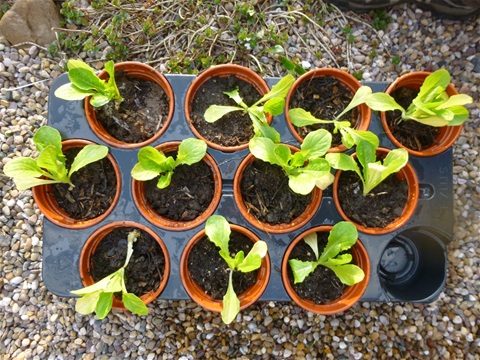Growing in Compost 1
Compost Awareness Week 2022 May 1 -7th
Schools or Allotment /Community Garden project
Comparing growth in different composts could provide a simple but photogenic project for children at school or on allotments. A group or class could use pots of different composts to grow plant purchased in strips from the greenhouse or from the local garden centre. The compost could be commercially available comparing different brands, or peat and peat free or taken from home composting bins.
At Stokes Wood Allotment we are using samples taken from dalek bins, a Green Johanna, Hotbin, Pallet bins (one which has over-wintered), and an anaerobic heap. Cos Lettuce are being used as the test plant as they make good leaf growth and should photograph well.
If photos are sent to carryoncomposting@gmail.com we will publish them on the website, or they can be posted directly to https://www.facebook.com/carryoncomposting
Planting in Compost
Home Compost is traditionally applied to the soil as a mulch, in a layer an inch or two thick, to provide organic matter to improve the structure and properties. A gap will be left round the plants so that the compost does not make direct contact.
Indeed, if searching the internet under “growing in compost, it would appear that the general consensus is that compost should form only a small proportion of the “soil” material and that it is not advisable to grow directly in compost. Although the evidence of your own eyes, during the season after composting plants such as tomatoes, pumpkins and squash, may show that at least some plants survive and grow well in pure compost heaps.
Despite this, the view remains that compost will “burn” plants heating up as its organic content breaks down. This tends to assume that immature compost is being used before the composting process has been completed rather than waiting until it has matured if it is to be used near growing plants. Burning is also said to occur where manure-based compost has a high phosphorus content or is used without be left a season to mature. As manure-based compost will not be used by most home composters this should not be a problem and if manure is used at all, it will only be in small amounts as an activator
Another reason given for not growing in compost is that has inadequate water retention. This assumes the grower does not check the moisture content of the growing medium and apply water if it is dry. Some also argue that the structure of the compost will not support tall plants, which assumes tall plants are not staked and that in the garden roots will not grow through the compost layer into the soil.
It is also said that the pH level might be unsuitable. This is easily checked most vegetables favour a pH between 6.0 and 7.0 or 7.5 and most finished home compost has a pH of 6-8
The answer to the question might be provided by no-dig gardeners who plant into compost and can often show a higher yield than obtained by those who dig When starting a bed, a 15cm/6in compost layer will often be used on top of layers of cardboard. The plants will initially grow in the compost eventually reaching into the soil which will provide support. Once no dig is established vegetables beds, will benefit should receive about 1in/3cm of compost each year.

Latest comments
Do you have any data on ' application ' of Aerated Vermi Compost Tea to Mangoes and benneficial outcomes .
Very informative site. Having been away for 5 weeks and returning to evidence of rats under and around the compost bin, I can testify to lack of human activity allowing the rats to get comfortable.
can i use dog manure in compost and mulching leaves?
What is the C and N ratio for coffee chaff?